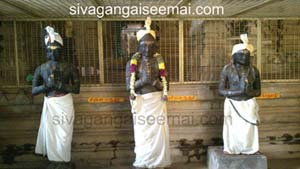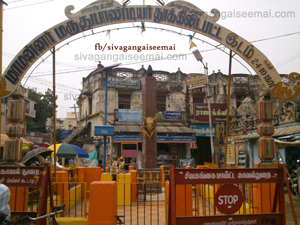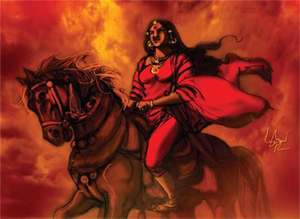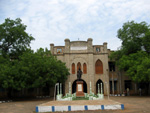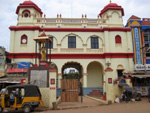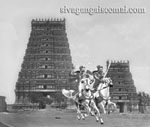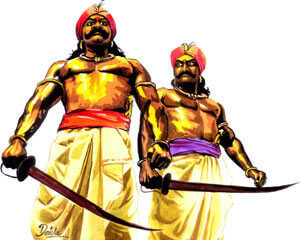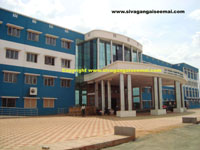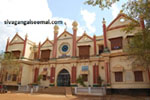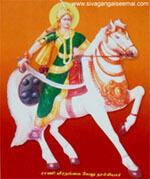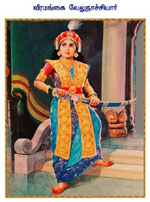Sivagangai History and Photographs
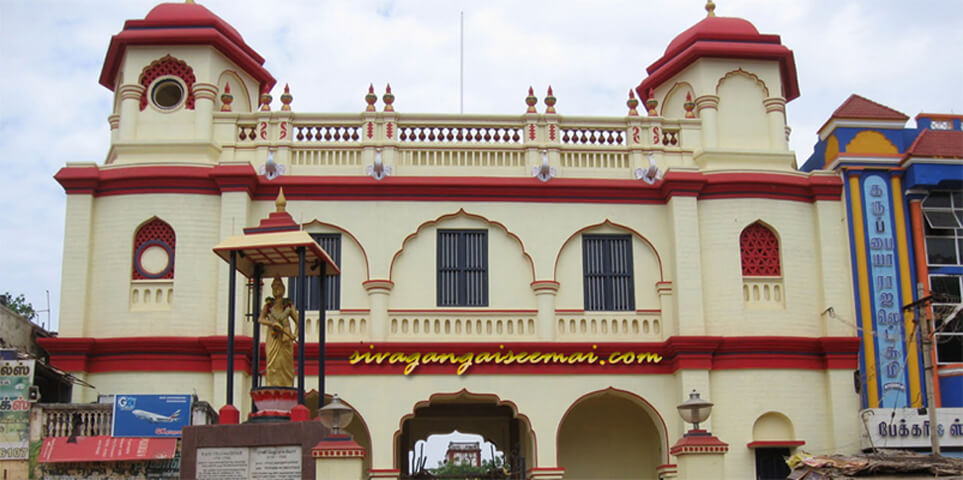
SASIVARNA THEVAR BECOMES THE POLIGAR OF NALUKOTTAI
According to tradition, the original seat of Sivagangai family is Naalukottai near Sholapuram. Regunatha Sethupathy alias Kilavan Sethupathy of Ramnad (1674-1710) invested one Peria Oodaya Thevar of Naalukottai with the rank of a Poligar or military chieftain. He granted him lands for the support of three hundred troops. He also conferred on him the title of “Naalukottai Poligar”. Just before his death in 1710, Kilavan Sethupathy of Ramnad nominated Vijaya Regunatha Sethupathy as his successor to the throne of Ramnad. He reined Ramnad from 1711 to 1725. He was the eighth Sethupathy of Ramnad. It was during his reign that Naalukottai family came into prominence. Peria Oodaya Thevar of Naalukottai became closely associated with Vijaya Regunatha Sethupathy of Ramnad. The Naalukottai Poligar received a further mark of royal favour by the marriage of his son Sasivarana Thevar to Ramnad king’s (illegitimate) daughter Akilandeswari Nachiar. The king Regunatha Sethupahy of Ramnad gave Sasivarna Thevar lands as dowry, free of taxation, sufficient to maintain 3,000 men. Vijaya Regunatha Sethupathy the king of Ramnad nominated many chiefs whom he created to guard several fortresses, which were built to protect Ramnad country from his enemies. He placed Sasivarna Thevar in charge of the fortresses of Piranmalai, Thiruppathur, Sholapuram and Thiruppavanam as well as the port of Thondi. Vijaya Regunatha Sethupathy died in 1725. Sundareswara Regunatha Sethupathy became the Ninth king of Ramnad in 1726. Bhavani Sankaran, the illegitimate son of Kilavan Sethupathy and a pretender to the throne of Ramnad invaded Ramnad with the help of the Rajah of Tanjore. He promised the Rajah of Tanjore that he would give all the country north of Paambar in the event of his being successful in the conquest of Ramnad. He conquered the territory of Ramnad. He arrested Sundareswara Regunatha Sethupathy, the legitimate king of Ramnad and sent him to Tanjore and finally put him to death. Bhavani Sankaran proclaimed himself the Rajah of Ramnad and thus he became the 10th king of Ramnad. He ruled Ramnad kingdom from 1726 to 1729. He did not however fulfil the promise he had made to the Rajah of Tanjore. He attempted to arrest. Kattaya Thevan, the brother of the late Sundareswara Regunatha Sethupathy. So Kattaya Thevan f led from Ramnad and sought asylum with the Rajah of Tanjore.
SASIVARNA THEVAR MEETS SATHAPPIAH, THE GNANI
Marudu or Murdoo as it was written by the English, was their family title, not a personal name. Marudu is the name of a tree, the Terminalia alata At the temple of Nainarkovil, in the Ramnad Zamindari, Siva is supposed to have appeared in the shape of a lingam at the foot of a Marudu tree. Hence, as worshipped in that place, he is called Marudappa or Marudesvara. This being the family divinity of the Siruvayal people, each of them, in honour of their divinity, took the title of Marudu. Servaikaran was the caste title, Marudu the family name both the chiefs were called Marudu, with this distinction only, that one was Periya, the elder, and the other Chinna, the younger. Periya Marudu was the nominal ruler of the country. It is he that is meant when the Sherogar or the Marudu is mentioned, but the real ruler was Chinna Marudu. The elder brother devoted himself wholly to field sports and left the administration of affairs in his younger brother’s hands.
Of the two brothers.......... the elder brother was called Wella or Velli Murdoo, but he had nothing to do with the management of the country. He was a great sportsman, and gave up his whole time to hunting and shooting. Being a man of uncommon stature and strength his chief delight was to encounter the monsters of the woods; and it was even said, that he could bend a common Arcot rupee with his fingers. Unencumbered with the cares or trappings of government, he led a sort of wandering life.
The Cheena (Chinna) Murdoo was ostensible sovereign of an extensive and fertile country, and his general residence was at Sherewele (Siruvayal). Though of a dark complexion, he was a portly, handsome, and affable man, of the kindest manners, and most easy access and though ruling over a people to whom his very nod was a law he lived in an open palace, without a single guard, indeed when I visited him in February 1795, every man who chose to come in, had free ingress and agress while, every voice called down the blessing of the Almighty upon the father of his people.
As the father of the Maruthus was an Army Commander, they received military training from him. They started their career as menial servants in the palace of Raja Muthuvaduga Thevar of Sivagangai. By dint of their ability they rose high. They acted as the Minister and Dalavoy of the Raja. After the death of Muthuvaduga Thevar they assisted Velunachi, the widow of Muthuvaduga Thevar.
SASIVARNA THEVAR’S ELEVATION
Sasivarna Thevar took leave of the Gnani and went to Tanjore. There he became acquainted with Kattaya Thevan, a refugee like himself. The Rajah of Tanjore fixed a certain date for a combat with the tiger and Sasivarna Thevar waited for the appointed day. No one ventured to fight with the tiger. At last brave Sasivarna Thevar came forward, fought with the tiger single handed and killed it. The Rajah of Tanjore was very much pleased with this braveful action of Sasivarna Thevar. At once he appointed Sasivarna Thevar as his a Aide-de- camp and placed him on an equal rank with him- He treated him with the utmost kindness, respect and regard.
SASIVARNA THEVAR GETS HELP OF THE KING OF TANJORE
A distant relative of the king of Tanjore aspired to succeed to the kingdom. He was plotting to put the ruling king to death. To compass this end, he ingratiated himself into the good graces of king’s Dalavoy or commander in chief. They conspired a plan to invite the ruling king to witness a bull fight, a pastime in which he took delight. It was plotted to drive a ferocious bull towards the king to kill him. When the ferocious bull ran towards the king to attack him, his favourite Aide-de-camp Sasivarna Thaver went to his rescue. He hold the bull’s horns with one hand and cut off them with his sword. He kicked the bull with great force and it fell unconscious on the ground. This incident raised Sasivarna Thevar in the estimation of the king. He wanted to know from Sasivarna Thevar what his aim in coming to Tanjore was. Sasivarna Thevar narrated the whole history of his life. He desired the Raja’s help in recovering his lost possessions (palayam) from Bhavani Sankaran in Ramnad Territory. The Rajah at once complied with his request. He ordered his Dalavoy to go with a large army to invade the Ramnad kingdom and directed him to act under the orders of Sasivarna Thevar and Kattaya Thevan of Ramnad.
Sasivarna Thevar and Kattaya Thevan at once proceeded to Ramnad with a large army furnished by the king of Tanjore. They defeated Bhavani Sankaran at the battle of OORIYUR and captured Ramnad in 1730. Thus Kattaya Thevan became the 11 th king of Ramnad. The territory lying north of PAAMBAR river was given over to the King of Tanjore as Kattaya Thevan had promised.
BIFURGATION OF RAMNAD COUNTRY – THE EMERGENCE OF SIVAGANGA COUNTRY
A distant relative of the king of Tanjore aspired to succeed to the kingdom. He was plotting to put the ruling king to death. To compass this end, he ingratiated himself into the good graces of king’s Dalavoy or commander in chief. They conspired a plan to invite the ruling king to witness a bull fight, a pastime in which he took delight. It was plotted to drive a ferocious bull towards the king to kill him. When the ferocious bull ran towards the king to attack him, his favourite Aide-de-camp Sasivarna Thaver went to his rescue. He hold the bull’s horns with one hand and cut off them with his sword. He kicked the bull with great force and it fell unconscious on the ground. This incident raised Sasivarna Thevar in the estimation of the king. He wanted to know from Sasivarna Thevar what his aim in coming to Tanjore was. Sasivarna Thevar narrated the whole history of his life. He desired the Raja’s help in recovering his lost possessions (palayam) from Bhavani Sankaran in Ramnad Territory. The Rajah at once complied with his request. He ordered his Dalavoy to go with a large army to invade the Ramnad kingdom and directed him to act under the orders of Sasivarna Thevar and Kattaya Thevan of Ramnad.
Sasivarna Thevar and Kattaya Thevan at once proceeded to Ramnad with a large army furnished by the king of Tanjore. They defeated Bhavani Sankaran at the battle of OORIYUR and captured Ramnad in 1730. Thus Kattaya Thevan became the 11 th king of Ramnad. The territory lying north of PAAMBAR river was given over to the King of Tanjore as Kattaya Thevan had promised.
THE ORGIN OF SIVAGANGA TEPPAKULAM AND “GOWRI VILASAM” PALACE
There are different versions regarding the origin of the Teppakulam and the palace in Sivagangai. Our late Poet Laureate KANNADASAN in the film SIVAGANGAI CHEEMAI sang thus.
“Oh Breeze! Won’t you blow in order to herald the arrival of peace in the land of the Maravas (SIVAGANGAI CHEEMAI) who were immortalised for their valour?” What made him sing so? The then Maravar Nadu including Sivagangai was a place over which the murky and reddish clouds of war were gathering. Tolled the death knell to the existence of the peace?. The First War of Indian Independence, which was termed as “Sepoy mutiny” by the English historians on account of their political animosity towards the people of India, has been considered to be the first uprising against the Britishers. But long before that epoch making event in reality in 1772 Rajah Muthu vaduganatha Thevar the second Rajah of Sivagangai who fought with Herculean valour against the Britishers met with a heroic death at Kalaiyarkoil. Another significant event to be recorded in the history of Sivagangai was the execution of the Great Marudu brothers in 1801 by the Britishers at Thiruppathur. One more subsequent event in the annals of “The Great Maravas” was the banishment of Vengai Peria Woodayana Rajah in 1802 by the Britishers. Ofcourse, the British East India Company which was established with a view to carrying on trade was determined to bring our country under their control taking advantage of beef wittedness of the people of India and their lack of unity.
“The GOWRI VILASAM” the palace of the Royal House of Sivagangai which was built at the heart of Sivagangai, the Capital of modern Sivagangai District as a historical monument and as the seat of all the past glories and heroic deeds of the then Marava Kings is now being left uncared with a scorching look of veritable Sahara. The history of the origin of Sivagangai is amusing with sorrowful beginning and dolorous ending.
Para Rajakesari Kilavan Sethupathy who was on the throne of Ramnad from 1674 to 1710, gave Naalukottai a small village six miles away on the northern side of Sivagangai as a gift to Kandumeki Sivarama Sasivarna Woodaya Thevar in appreciation of his bravery. Furthermore, he was given somemore villages surrounding Naalukottai and the revenue from these villages would enable him to maintain a battalion of 300 soldiers.
The death of Kilavan Sethupathy the King of Ramnad in 1710 was followed by a war of succession to the throne and in that war of succession, the illegal son of Kilavan Sethupathy’s concubine, Bhavani Sankaran (1725-1728) emerged out with success. His hostility towards Sasivarna Thevar of Naalukottai made him step down from the throne of Naalukottai palayam. The dethroned Sasivarna Thevar having left with a grief and disappointment was one day sleeping under the shade of a Jambool tree. The fortune started began favouring him in the form of one great saint named Sri Sattapiah, who was sitting in deep meditation on the eastern side of the Jambool tree. Then a line of conch in the right palm of Sasivarna Thevar and circular lines in his feet fell in the sight of the saint. At once the saint was able to foresee that Sasivarna Thevar had a bright future. Sasivarna Thevar, who woke up from his sleep, prostrated before the saint and begged for saint’s blessings after narrating him a vivid picture of his sufferings and hardships. As instructed by the hermit, Sasivarna Thevar had a dip in the holy water of a nearby spring and then the sacred ash or vibuthi was put on his forehead, as a mark of blessing. The saint also taught him a secret mantra in his ears. The sacred spring in which Sasivarna Thevar had a dip is now at the heart of the town bearing the name “SIVAGANGAI” There is another story which tells us about the name of “SIVAGANGAI” A ferocious tiger red in colour was sleeping near a bush where the hermit was in deep meditation. The word “Sivagangai” is said to have been derived from the word “SHEV VENGAI’ which means “Red Tiger”.
It was with the blessings of the hermit Sathappiah, Sasivarna Thevar went to Tanjore to seek the succour of the king of Tanjore. He was waiting for an audience with the king for many a day. At last his patience was duly given shape when a wild tiger entered the palace of the king. The fear-stricken people inside the palace could not drive it out. The propitious moment came to Sasivarna Thevar whose deft fists put the tiger to death. Having been pleased with Sasivarna’s bravery and valour , the king of Tanjore gave him the status of his personal bodyguard. Then the Kattaya Thevan took asylum in King’s palace for fear of being done to death by Bhavani Sankaran of Ramnad.
The King of Tanjore was very fond of bull fight game and every year it was conducted on a festive occasion. A close relative of king who was aspiring for the throne of Tanjore plotted to kill the king while the bull fight game was going for he hatched a plan. The plan was to make a trained bull to spring upon king to snatch away his life. In accordance with the pre-arrangements made by the traitor inside the bull-fight arena, where the king was seated, the trained bull would attack and kill the king instead of the competitor. He wanted to make others to believe that the attack of bull on the king was nothing but accidental and not a plot already hatched against his life.
The king was witnessing the bullfight. While the bull as well as the competitor was struggling hard to win over one another, the bull quite unexpectedly attacked the king. In the wink of an eye, Sasivarna Thevar, the bodyguard of the king jumped in between the king and the bull and the ferocious quadruped fell a prey to the sinewy arms of Sasivarna Thevar. The sinister motive of the traitor did not bear fruit.
The king of Tanjore saturated with joy and asked Sasivarna Thevar what he wanted in return for his heroic deed? Sasivarna Thevar who had been in anticipation for an opportunity to get succour from the King, gave a vivid picture of his banishment by Bhavani Sankaran. He wanted the Rajah’s help in recovering his lost Naalukottai palaym from Bhavani Sankaran. The Rajah ordered his Dalavoy Ananda Rao Peshwa to go with a large army to invade the Ramnad kingdom. He also directed him to act under the orders of Sasivarna Thevar and Kattaya Thevan of Ramnad. The Dalavoy defeated Bhavani Sankaran at the battle field of OORIYUR in 1729. Then Ramnad was divided into five parts. He retained three parts for himself and granted two parts to Sasivarna Thevar. The region comprising two parts came under the flag of Sasivrna Thevar. The history of Sivagangai commences from 22.01.1730. The first king of Sivagangai was Sasivarna Thevar who came to be called Kandumekki alias and officially Rajah Muthuvijaya Regunatha Sivarama Sasivarna Peria woodaya Thevar. (1730-1750)
In compliance with the wish of the hermit who blessed Sasivarna with kingship the surrounding forests of Sivaganga were destroyed. The sacred spring was modified into a beautiful tank ( Teppakulam ) A palace was also constructed near by using the earth dug out. Sivagangai is called “Kandaga Boomi” ( sulphar land) because of its climatic condition. It bears the name Dakshina Kalipura in Sanskrit. Those who on pilgrimage to Rameswaram must come to Sivagangai to bathe in the afore cited tank and then only they can have the benefit of their pilgrimage.
THE SIVAGANGA PALACE
In 1736 Chanda Sahib defeated Bangaru Thirumalai Nayak from Dindugal and his son Vijaya Kumar in the battle of Ammayanayakanoor. They came to Sivaganga to take refuge inside the palace of Sivaganga. The Veerapandia Kattabomman had frequent and secret consultations with the Marudu brothers in this palace for driving away the English from this soil. After the execution of Kattabomman, Kumarasamy alias Oomaidurai, the younger brother of Kattabomman sought succour of Chinna Marudu and took asylum in this palace.
In 1763 “Kammandan Khan Sahib of Madurai Subha attacked this palace. In June 1772 the British commanders Col Joseph Smith, Lt Col. Banjour and Ummat-ul-umara, the son of the Nabob of Carnatic attacked this palace with cannons. In May 1789, the army of Vijaya Regunatha Raya Tondaman of Pudukottai attacked this palace under the command of Col. Stuart In 1775 Mohammad Ali, the Nabob of Carnatic changed the name of Sivagangai as “Hussain Nagar”. But as a result of stiff resistance from the people of Sivagangai by protesting before this palace, the change of name was dropped.
This palace withstood so many attacks and invasions. But now it has lost its grandeur and is slowly sinking into the earth. The Gowri Vilasam is a building of later period. It was built by Padamathur Gowry Vallabha Thevar (1801-1829). The only part of Sivagangai palace which was intact had the compound wall of 18 feet height and 5 feet wide. The strength of the wall was due to the mortar mixed with eggs, gallnut and sugar cane juice used in the construction of this wall serving as a fort. This compound wall has been demolished and a number of stalls are rented out by the members of the Royal House of Sivagangai.
The facade of the palace is fascinating. It has been built in architectural designs of Tirumalai Nayak’s time. We find traces of Rajaputana arts. On the southern side of the frontage, there is a big clock atop which is not in working condition for a long time. If we go inside the palace, we find a broad open space. Once the Durbar Hall of the kings was situated here. It was here the great poets like Santhupulavar, Sakkaripulavar, Savvadhu pulavar, Kandasamy pulavar, Kuladaikavt, Madurakavi, Kavi Kunjara Bharathi, Villiappapillai, Vembathur Pichuvaier, Venpaapuli Kavirayar and Kamudi Pulavar were duly honoured and richly rewarded for their poetic talents and merits.
Rajah Doraisingam Memorial College was housed in this palace in August 1947, for a short period. It continued to function here till the completion of construction of a new buildings on the southern outskirts of the town.
It we go west of the open space inside the palace, we find the Temple of Goddess Raja Rajeswari Amman. Maintained by the Royal house of Sivagangai. Inside the temple, there is a statue of the king” Kandumekki Woodaya Taver”. The mural paintings here are decades old and they have been white washed over. The Goddess of this temple Raja Rajeswari is the family deity of the kings of Sivagangai. The public are also now allowed to go and worship the Royal deity. Papanasa Sivan, the great composer of tamil songs had sung songs in praise of this deity. For example “ Suganagarani Sirashami” is one such song composed by him.
There was a guilt kalasam on the top of the dome of the building in the north western corner and now such a guilt kalasam is nowhere to be seen. There was a sentry yard at the top of this dome to guard the palace. Inside, we find a genealogical list of kings and Zamindars of Sivagangai Zamin with some chronological overlapping (reigning period) noted therein.
There is a record office opposite to this temple built by Bodha Gurusamy Rajah II in 1862. It needs immediate attention to protect it from falling down. It is in a dilapidated condition which may give way of its foundation at any moment. In 1864, during the reign of Rani Kaatham Nachiar, the Record office was modified transformed into an armoury. From this place, Valari Kambu (a weapon of boomerang type) and some other weapons have been taken and kept in the museum in Ramanathapuram. The throne of Sivaganga king’s is now kept in the museum at Ramnad.
There is a royal summing pool on the northern side of the temple for the use of palace queens exclusively. The swimming pool is constructed in such a way that every day clean water was passed into the swimming pool for queen’s bathing. The water was passed through an underground duct, which was closed during a road repairing was done. After the queen had completed her bathing the used water was allowed to percolate through an outlet. Even” the king” was prohibited from entering this area during bathing. Perhaps it may be used for bathing exploits and amusements. There is a duct from the Teppakulam leading into this swimming pool for filling it with water. This tank built of rocky stones has facilities for playing various games like hide and seek games in water.
Near the swimming pool there lies a tall building with royal balcony in which the queens preening their hair after bathing. There is a marriage hall (Kalyana Mahal) in the south of the temple where there are pillars of sculptural beauty and excellence. The auspicious functions of the Royal household were celebrated here. Ministers, important dignitaries, Dalavais, Dewans, Peishkars, Purohits (priests) visited this palace for consultations.
After the death of Padamathur Gowri Vallabha Woodayana Tevar Muthu Vaduganatha Thevar II (1830-31) who usurped the kingship afterwards planned their schemes here. Rani Velu Nachiar, (1772-80) Rani Vellachi Nachiar (1780-90) and Rani Kaathama Nachiar (1864-77) the queens of this palace used to stay in this hall. The most famous pieces of this “Gowri Vilasam” palace are the BLACK MARBLE SQUARE” This place had been the centre of amusements, entertainments, dancing, plotting and negotiations, there is a small hall supported by black marble stone on the back of this palace. There is a seat of stone carved entirely out of black marble. The kings sat on this seat and settled many civil cases arbitrarily.
Padamathur Gowri Vallabha Woodayana Thevar (1801-1829) after a short illness died at 3 p.m. on 17.06.1829. Immediately his brother Oyya Thaver entered this palace accompanied by his three sons and his followers. He told the crowd that if the king died inteste the British East India Company would annex this kingdom. Saying so, he asked them to crown his eldest son Muthu Vaduganathan as king. He sat on the black marble square and prepared a false Will. He forged the signature of Padamathur Gowri Vallabha Woodayana Thevar and sent this Will to the Collector and also to the District Judge at Madurai. It was on this seat of stone that the coronations of Rani Kaathama Nachiar and her son Muthu Vaduganatha Tevar III took place. The kings who succeeded him followed the same practice of holding their coronations here.
The zenana or the harem parts of this palace contains many secret passages. There is a narrow subterranean passage below the balcony. Only one man can walk along this narrow passage. This is said to be an emergency exit to enable the women folk of the palace in times of danger. The structure of the Royal chamber is wonderful. The entrance is modelled in such a way that one man can stay there and fight against many. This was the last resort of the people of this palace to escape. When Khan Sahib invaded Sivaganga in 1763, this secret way was used. Whenever a new king ascended the throne, the queens were informed of this secret way. This secret way which saved many kings and queens in danger is now remains in an abandoned state.
There were many accasions when Sivagangai Zamin was pledged for debt. Periasami alias Woodayana Taver (1883-1898) leased the Sivaganga Zamin to three Europeons R.G. Orr, Royan and Stranack on 23.05.1887.These Europeons built new bungalows in Sivagangai town later called new palace. They returned the Zamin to the king in 1918. Doraisinga Rajah (1898-1941) then kings left this palace forever and occupied the Europeon bungalow. From that day onwards, the glory and prominence of Gowri Vilasam palace began to wane.
The town of Sivaganga was formed surrounding this palace with the octagon shaped tank which is on the northern side of the palace. There is a well, known as ”Nadu Theppakkulam“ at the centre of the tank with other six small wells around it.
The water coming from the northern side of the tank flows in through an inlet on the north. The surplus water flowing out is taken out through two outlets on the southern part of the tank. The steps on the northern side of the tank known as”YANAIPADI” had been used for taking the royal elephants for bathing. There are two separate bathing ghats on the southern side of the tank for men and women, where as the ghat on the east as well as on the west are used only by the women. The two inlets connected with the subterranean tunnel on the western side of the tank to take the water to the tank on the northern side of the family deity of Raja Rajeswari temple of the Royal House of Sivagangai.
The water in the big tank outside the palace, and the water inside the palace tank used for bathing of the women of the Royal house hold (Royal swimming pool) are green. The walls around the tank are built of strong stones. The statues of Lord Vinayaga yechi, spear, yazhi, veena,shield, pillars and rows of bells etc. connected with the History of Sivagangai have been chiselled into the stones. They describe honours with which the Sivagnaga kings were glorified. The human sacrifices made for the recovery of the kings from illness, prayers held for the victory of the kings in the wars, the benevolent services rendered by the kings of Sivagangai during, famines and floods self immolation by women into the fire and by others ways are found engraved on the stones.
Alaudin Khilji who was on the throne of Delhi from 1292 to 1312 invaded the South in 1310 Malik Khafur, a member of the depressed classes and an eunch having embraced Islam and won the confidence of the Sultan commanded the forces. After plundering Madurai, he proceeded to Rameswaram with 1512 elephants and 5000 horses. On the way he destroyed the Murugan temple built by Sadayavarma Sundara Pandian at Kovanoor. Sundara Pandian reined the Pandya Kingdom from 1251 -1268. The heaps of stones around the destroyed temple at Kovanoor were used for constructing the steps of Teppakkulam at Sivagangai. There is one Hanuman temple on the northern side of the tank and there is another Ganesh temple (Gowri Vinayakar) temple on the western side. It was built by Pazhayanoor Karuppayee tha maid-in- waiting of Rani Velu Nachiar, the third ruler of Sivagangai kingdom. Thus the tank has been the origin of the history of Sivagangai.
This Velu Nachiyar History taken from the book of A STRUGGLE FOR FREEDOM IN THE REDSOIL OF SOUTH wrote by Mr.Balakrishnan [Headmaster Retired]I thank very much to Mr.Balakrishnan [Headmaster Retired] sir for help me to publish this history in to our website. Anyone want to buy this complete book by parcel mail me @ muthukumaran@scmaidigital.com,
Thanks. Muthukumaran Swaminathan - Like Our Official Facebook Page for More Updates
Quick Links
Maruthupandiyar History in English
Read Maruthupandiyar History in English...
Maruthu Pandiyar History in Tamil
Read Maruthupandiyar History in Tamil...
Velu Nachiyar History in Tamil
Velu Nachiyar History in Tamil...
Sivagangai Palace
Sivagangai Palace photo gallery to view Read More ......
Sivagangai Car Festival
Sivaganga Photo Gallery
2008 - www.sivagangaiseemai.com
ALL Rights Reserved. Privacy Policy

